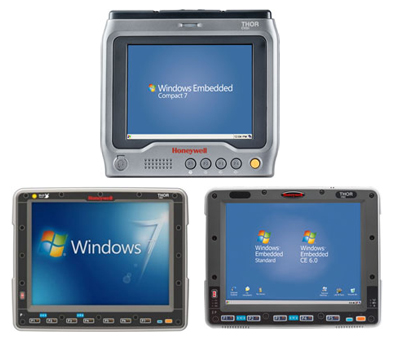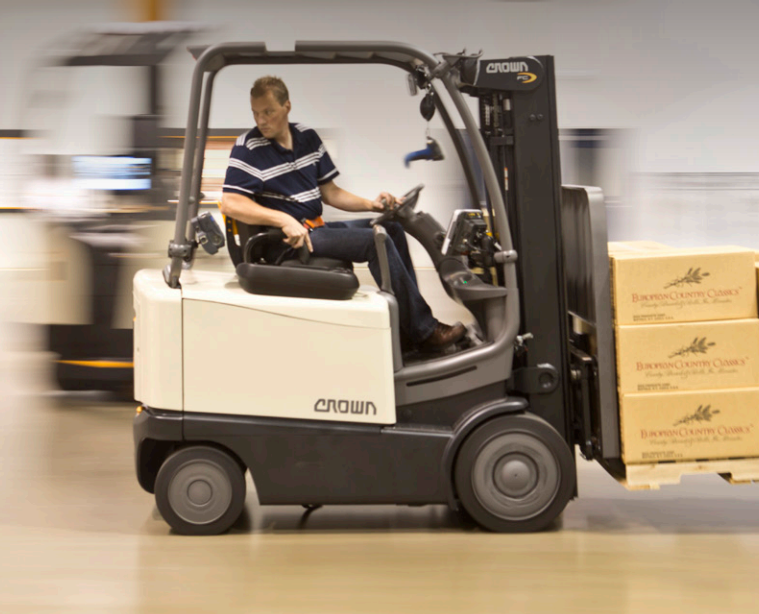Maximizing Return on Investment When Purchasing Forklift Mount Technology

Keeping up with and knowing how to best leverage both the latest forklift technology with the best docking and mounting solution in today’s Material Handling and Distribution industry is at the core of maximizing a profitable operation. Prioritizing the importance of return on investment (ROI) as a key deliverable in a technology/docking/mounting purchase decision is critical in balancing today’s cost with its’ future value or ROI. Understanding first how to calculate labor productivity and then reviewing 4 important advantages that improve productivity will ultimately improve the bottom line. They are:
- Increased Capabilities and Performance
- Increased Flexibility
- Improved Technology Safety and Performance
- Improved Overall Productivity
It starts with calculating your current process labor productivity using the mathematic calculation detailed here:

Once labor productivity is identified, researching both the best technology options available with the best docking and mounting solution that allows improved labor times is the next step and where Barcodes, Inc. adds immense value. As a full-service technology provider, Barcodes, Inc.’s core competency is delivering convenient, complete and effective solutions.
This is accomplished by understanding individual needs and making recommendations based on delivering on these four advantages that result from improved technology/docking/mounting solutions.
Increased Capabilities and Performance – The number one driver in your decision to initially purchase or upgrade your current technology/docking/mounting configuration is understanding not just the technology benefits, but the benefits of your docking and mounting solution. This is as critical a component as the technology itself. Gamber-Johnson, one of Barcodes, Inc. long time technology docking and mounting manufacturing partners, offers commercially designed, rugged, reliable, and responsive solutions specifically for Material Handling duty cycles. It is this combination that fully maximizes the results of increased capabilities and performances.
Increased Flexibility – Improving user flexibility through unique design features and capabilities of technology/docking/mounting solutions is also a key driver to improved ROI. Offering you a choice of a standard mounting solution or designing a personalized mounting solution (if required minimum order quantities are met) is something Barcodes, Inc. representatives and Gamber-Johnson offers. Working together, we can design, test, and build a custom docking/mounting solution that can greatly enhance the flexibility you need to improve productivity while providing you a simple, convenient purchasing and install process saving you precious time.
Increased Technology Safety – Protecting technology when installed in the dock and mount is critical. Primary vibration passing through a forklift when encountering an uneven surface is magnified immensely and directly affects a docking/mounting combinations ability to absorb severe vibration without failure. Why a rugged, reliable, responsive design to meet the harsh criteria of a typical material handling duty cycle is critical, especially when making a long-term purchasing decision. To maximize productivity and ultimately ROI, dock/mount failure is not an option.
Proving Overall Productivity – Real-time testing of the best identified technology/docking/mounting combination and comparing the improved process timing using it to original labor productivity data captured quantifies time savings and ROI increases. Multiplying that number into the future cements payback time and the residual incremental profit thereafter completing the improved ROI exercise. It all starts by simply contacting your local Barcodes, Inc. representative to understand, develop and ultimately provide you with the complete turnkey solution to your team’s specific needs and requirements to maximize ROI and deliver incremental revenue. Contact Barcodes, Inc. for a free consultation today.
Things to Consider When Mounting To Your Forklifts
With different environments and users all under one roof, it is important to have a product that can tolerate the rigorous demands of material handling. Whether the best solution is mounting a device horizontally on the overhead guard leg or vertically off the overhead guard leg, Gamber-Johnson has a solution for every user’s unique needs.
Barcodes, Inc. is ready to assist with your next warehouse material handling solution. Contact us today for a free consultation.
Key Benefits of Vehicle Mount Terminals
 Look into any mid to large scale warehouse operation and you will see vehicle mount terminals in use to improve efficiencies across the facility. Especially in the case of forklifts, embedding a capable mobile terminal can improve productivity and reduce errors from the docks to the yard. Having access to accurate information at all time in real-time aids in every process from receiving to storing, moving around, cross docking and picking.
Look into any mid to large scale warehouse operation and you will see vehicle mount terminals in use to improve efficiencies across the facility. Especially in the case of forklifts, embedding a capable mobile terminal can improve productivity and reduce errors from the docks to the yard. Having access to accurate information at all time in real-time aids in every process from receiving to storing, moving around, cross docking and picking.
Key Benefits of Vehicle Mount Terminals
- The vehicle terminal tells your driver exactly what items to pick-up
- The driver has detailed information at all times on where to store product such as a bin or rack number and can confirm the putaway is complete
- The terminal can track product in real time while it is being moved within your warehouse or even cross docked for immediate shipping
- The real time accuracy of information right in the vehicle that is picking the product eliminates human error in selecting the wrong product
- AÂ vehicle mount computer than can immediately confirm the right product is being moved onto the right truck for shipping, eliminating human error
Five Things to Consider When Using Tablet Computers in Forklift Applications
 Why Tablets and Purpose Built Forklift Mounted Computers Are Not Interchangeable
Why Tablets and Purpose Built Forklift Mounted Computers Are Not Interchangeable
Tablet computing is one of the fastest-growing categories of consumer electronics and enterprise IT alike. The buzz is leading many businesses to explore new uses for tablet computers, and some are finding their way into evaluation trials on forklifts and other vehicle applications in the distribution center. With their large screens and available Windows operating systems, tablets can seem quite similar to the forklift-mounted computers that are widely used today. They can also be taken off the forklift and used on the floor, which some organizations find intriguing.
However, tablets should not be considered drop-in replacements for purpose-built forklift mounted terminals because there are several major differences between the product categories. If you are considering using tablet computers on forklifts, it is important to know these differences and how they may impact operations. Careful evaluation will highlight compromises in integration and everyday use.
Motorola Vehicle Terminals – Infographic
Meeting the physical demands of a warehouse environment, especially in the case of forklift use, can be a daunting task for most mobile computers and tablets. Many mobile devices may have a rugged outer case but dealing with vibration and misuse on a vehicle/forklift requires even more specific design changes few devices have.
Motorola offers a range of terminals designed for vehicle use and can handle every application from the warehouse to cold storage and even the outdoors. This infographic is a quick overview of the key Motorola vehicle terminals and their main features to get you started finding the right unit for your needs.
Five Things to Consider When Using Tablet Computers in Forklift Applications
Why Tablets and Purpose Built Forklift-Mounted Computers Are Not Interchangeable
Tablet computing is one of the fastest-growing categories of consumer electronics and enterprise IT alike. The buzz is leading many businesses to explore new uses for tablet computers, and some are finding their way into evaluation trials on forklifts and other vehicle applications in the distribution center. With their large screens and available Windows operating systems, tablets can seem quite similar to the forklift-mounted computers that are widely used today. They can also be taken off the forklift and used on the floor, which some organizations find intriguing.
However, tablets should not be considered drop-in replacements for purpose-built forklift mounted terminals because there are several major differences between the product categories. If you are considering using tablet computers on forklifts, it is important to know these differences and how they may impact operations. Careful evaluation will highlight compromises in integration and everyday use.
This post reviews some of the important differences between tablets and purpose-built computers for forklifts, and presents the five key issues that must be considered when assessing tablet computers for forklift operators:
- Is the design and mounting appropriate for a warehouse or distribution center environment?
- How will the tablet be powered from the forklift?
- Is the tablet compatible with data collection equipment(scanners, printers, RFID), legacy warehouse management system (WMS), fleet management solutions and other critical enterprise systems?
- How will tablets impact user processes and productivity?
- How much will tablets really cost?






